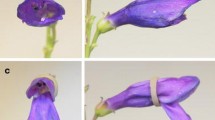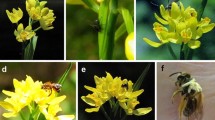Abstract
Pollen dispersal by pollinators is governed by the extent to which diverse effects on pollinator behaviour act independently or augment or moderate each other. Using artificial inflorescences, we assessed the behavioural responses of bumble bees to inflorescence architecture (raceme, panicle, and umbel), inflorescence size (7 or 13 flowers), inter-inflorescence distance and the proportion of empty flowers per inflorescence. The advantage of large inflorescences in terms of attractiveness was larger for racemes and umbels than for panicles, whereas the effect of inter-inflorescence distance on the number of successive probes was smaller for racemes than for panicles and umbels. The number of flowers probed per visit increased almost proportionally with display size when fewer flowers were empty, whereas the number increased less when many flowers were empty. Our results suggest that display size and the spatial arrangement of flowers and nectar within inflorescences can contribute to efficient pollination by affecting pollinator behaviour interactively.




Similar content being viewed by others
References
Best LS, Bierzychudek P (1982) Pollinator foraging on foxgloven (Digitalis purpurea): a test of a new model. Evolution 36:70–79
Biernaskie JM, Cartar RV, Hurly TA (2002) Risk-averse inflorescence departure in hummingbirds and bumble bees: could plants benefit from variable nectar volumes? Oikos 98:98–104
Brunet J, Charlesworth D (1995) Floral sex allocation in sequentially blooming plants. Evolution 49:70–79
Charlesworth D, Charlesworth B (1987) Inbreeding depression and its evolutionary consequences. Annu Rev Ecol Syst 18:237–268
Cruden RW, Hermann SM, Peterson S (1983) Pattern of nectar production and plant-pollinator coevolution. In: Bentley B, Elias TS (eds) The biology of nectarie. Columbia University Press, New York, pp 80–125
Dornhaus A, Chittka L (1999) Evolutionary origins of bee dances. Nature 401:38
Dreisig H (1989) Nectar distribution assessment by bumblebees foraging at vertical inflorescences. Oikos 55:239–249
Dreisig H (1995) Ideal free distributions of nectar foraging bumblebees. Oikos 72:161–172
Fishbein M, Venable DL (1996) Evolution of inflorescence design: theory and data. Evolution 50:2165–2177
Fretwell SD, Lucas HL (1970) On territorial behavior and other factors influencing habitat distribution in birds. Acta Biotheor 19:16–36
Giurfa M, Vorobyev M, Kevan P, Menzel R (1996) Detection of colored stimuli by honeybees: minimum visual angles and receptor specific contrast. J Comp Physiol A 178:699–709
Goulson D, Hawson SA, Stout JC (1998) Foraging bumble bees avoid flowers already visited by conspecifics or by other bumblebees species. Anim Behav 55:199–206
Hainsworth FR, Mercier T, Wolf LL (1983) Floral arrangements and hummingbird feeding. Oecologia 58:225–229
Harder LD, Barrett SCH (1995) Mating cost of large floral displays in hermaphrodite plants. Nature 373:512–515
Harder LD, Jordan CY, Gross WE, Routley MB (2004). Beyond floricentrism: the pollination function of inflorescences. Plant Spec Biol 19:137–148
Hirabayashi Y, Ishii HS, Kudo G (2006) Significance of nectar distribution for bumblebee behavior within inflorescences, with reference to inflorescence architecture and display size. Ecoscience 13:351–359
Ishii HS, Harder LD (2006) The size of individual Delphinium flowers and the opportunity for geitonogamous pollination. Funct Ecol 20:1115–1123
Jordan CY, Harder LD (2006) Manipulation of bee behavior by inflorescence architecture and its consequence for plant mating. Am Nat 167:496–509
Kadmon R, Shmida A (1992) Departure rules used by bees foraging for nectar: a field test. Evol Ecol 6:142–151
Klinkhamer PG, de Jong TJ (1990) Effects of plant size, plant density, and sex differential nectar reward on pollinator visitation in the protandrous Echium vulgare (Boraginaceae). Oikos 57:399–405
Kudo G, Harder LD (2005) Floral and inflorescence effects on variation in pollen removal and seed production among six legume species. Funct Ecol 19:245–254
Kudo G, Maeda T, Narita K (2001) Variation in floral sex allocation and reproductive success within inflorescences of Corydalis ambigua (Fumariaceae): pollination efficiency or resource limitation? J Ecol 89:48–56
Liang KY, Zeger SL (1986) Longitudinal data analysis using generalized linear models. Biometrika 73:13–22
Lloyd DG (1992) Self- and cross-fertilization in plants. II. The selection of self-fertilization. Int J Plant Sci 153:370–380
McCullagh P, Nelder JA (1989) Generalized linear models. 2nd edn. Chapman and Hall, London
McDade LA, Weeks JA (2004) Nectar in hummingbird-pollinated neotropical plant II: interactions with flower visitors. Biotropica 36:216–230
Ohashi K, Yahara T (1999) How long to stay on, and how often to visit a flowering plant? A model for foraging strategy when floral displays vary in size. Oikos 86:386–392
Ohashi K, Yahara T (2001) Behavioral responses of pollinators to variation in floral display size and their influences on the evolution of floral traits. In: Chittka L, Thomson JD (eds) Cognitive ecology of pollination. Cambridge University Press, Cambridge, pp 274–296
Ohashi K, Yahara T (2002) Visit larger displays but probe proportionally fewer flowers: counterintuitive behaviour of nectar-collecting bumble bees achieves an ideal free distribution. Funct Ecol 16:492–503
Pyke GH (1982) Foraging in bumblebees: rule of departure from an inflorescence. Can J Zool 60:417–428
Prusinkiewicz P, Erasmus Y, Lane B, Harder LD, Coen E (2007) Evolution and development of inflorescence architecture. Science 8:1452–1456
Robertson AW, Macnair MR (1995) The effects of floral display size on pollinator service to individual flowers of Mysotis and Mimulus. Oikos 72:106–114
Rotnitzky A, Jewell NP (1990) Hypothesis testing of regression parameters in semiparametric generalized linear models for cluster correlated data. Biometrica 77:485–497
Smithson A, Gigord LDB (2003) The evolution of empty flowers revisited. Am Nat 161:537–552
Thakar JD, Knute K, Chauhan AK, Watve AV, Watve MG (2003) Nectarless flower: ecological correlates and evolutionary stability. Oecologia 136:565–570
Tindall JR (2006) The incidence and functional significance of nectarless flowers. M.Sc. thesis, University of Calgary, Calgary
Waddington KD, Heinrich B (1979) The foraging movements of bumblebees on vertical inflorescences: an experimental analysis. J Comp Physiol 134:113–117
Zimmerman M (1981) Optimal foraging, plant density and the marginal value theorem. Oecologia 49:148–153
Acknowledgments
We thank L.D. Harder for his critical comments on the manuscript and assistance with statistical analysis. In addition, two anonymous reviewers provided valuable comments on the manuscript. We also thank the member of Regional Ecosystems in Hokkaido University for building the flight cage, and A.M. Ishii for collecting data. This research was funded by a fellowship of the Japan Society for the promotion of Science to H.S.I. (no. 0124) and a Grant-in-Aid from the Ministry of Education, Culture, Sports, Science and Technology, Japan to G.K. (no. 15370006). The experiment complies with the laws of Japan, the country in which it was performed.
Author information
Authors and Affiliations
Corresponding author
Additional information
Communicated by Jeff Corner.
Rights and permissions
About this article
Cite this article
Ishii, H.S., Hirabayashi, Y. & Kudo, G. Combined effects of inflorescence architecture, display size, plant density and empty flowers on bumble bee behaviour: experimental study with artificial inflorescences. Oecologia 156, 341–350 (2008). https://doi.org/10.1007/s00442-008-0991-4
Received:
Accepted:
Published:
Issue Date:
DOI: https://doi.org/10.1007/s00442-008-0991-4




